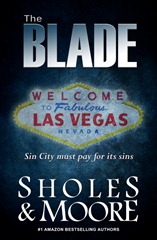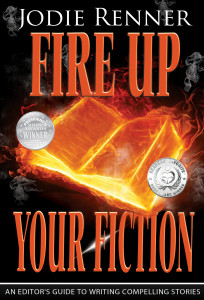 I’m pleased to welcome to TKZ my guest, Jodie Renner, freelance fiction editor and craft writer. Jodie is currently editing my next thriller THE BLADE (co-written with Lynn Sholes), soon to be released as an indie published e-book. Not only is she doing a great job of finding all our line and copy edit stumbles, but she’s got a keen knack for suggesting just the right content tweaks to help tighten the story. I asked Jodie to put together some thoughts and tips for writing action scenes. Here’s her terrific post. Enjoy!
I’m pleased to welcome to TKZ my guest, Jodie Renner, freelance fiction editor and craft writer. Jodie is currently editing my next thriller THE BLADE (co-written with Lynn Sholes), soon to be released as an indie published e-book. Not only is she doing a great job of finding all our line and copy edit stumbles, but she’s got a keen knack for suggesting just the right content tweaks to help tighten the story. I asked Jodie to put together some thoughts and tips for writing action scenes. Here’s her terrific post. Enjoy!
————-
Thanks, Joe! Great to be here.
I specialize in editing thrillers, and I sometimes get asked how editing suspense fiction is different from editing other genres. That’s a huge topic, too long for one blog post, and would include specific approaches to various elements like premise, plot, characterization, pacing, word choice, and writing style.
For this post, I’ll just talk about writing effective action scenes, which can appear in many other genres besides thrillers.
When your characters are running for their lives, or your hero is in a race against time to save innocent lives, it’s time to write tight and leave out a lot of description, especially little insignificant details about their surroundings. Characters on the run don’t have time to admire the scenery or décor, start musing about a moment in the past, or have great long thoughts or discussions. Their adrenaline is pumping and all they’re thinking of is survival – theirs and/or someone else’s.
Of course, if the details of the setting are significant or would somehow help or hinder your protagonist, then definitely include them. Basically, put yourself in the head and body of your character under stress, fighting for her life, and see/hear/smell/feel what she does, then react as she reacts.
SOME QUICK TIPS FOR WRITING STRONG ACTION SCENES
~ Show, don’t tell (of course!). Play the scene in real time, with actions, reactions, and dialogue.
~ Use deep point of view. Stay in the POV character’s head and body.
~ Avoid info dumps. Keep the readers right there in the scene with the characters. Don’t intrude as the author to clarify anything. If details need explaining, fit that in somehow before the tense scene starts.
~ Evoke the senses. Show your viewpoint character’s vivid sensory impressions, so the reader sees, hears, smells, tastes, feels what he does.
~ Amp up the imagery. Use the most concrete, suggestive nouns and the most powerful, evocative verbs you can find.
~ Show inner reactions. Reveal your POV character’s emotions, brief thoughts, and physical reactions, starting with their visceral responses.
~ Use tight, staccato thinking. Avoid long, involved thought processes, which deflate tension and slow things down.
~ Describe physical actions succinctly, for fast pacing and high tension. Don’t get into distracting minor details about which hand or finger or foot and exactly how high or low, unless it’s important for some reason.
~ Show other characters’ threats and reactions through their words, tone of voice, actions, body language, and facial expressions.
~ Use rapid-fire dialogue. Avoid complete, correct, thoughtful sentences and lengthy discussions among characters.
~ Write tight. Cut out any little unneeded words that are cluttering up sentences and slowing down the pace.
~ Use short sentences and paragraphs, for a tense, breathless, staccato effect. – Writers and readers – do you have any tips to add to this list?
SOME BEFORE-AND-AFTER EXAMPLES OF EFFECTIVE ACTION SCENES
(Well-disguised from my editing. The “after” examples are of course only one possibility among many.)
Before:
Fortunately for Jennifer, the attacker was far enough away that when he attempted to grab her she sidestepped him and delivered a sharp kick to the outside of his left knee. He grunted and fell back against the stack of wooden crates. He then got up clumsily, rubbing his arm, showing his anger at how easily Jennifer had dodged and hit him.
After:
The attacker lunged at Jennifer. She dodged to the side and delivered a sharp kick to his knee. He grunted and fell against the stack of wooden crates. He scrambled up, rubbing his arm, eyes full of hate.
Before:
His facial expression changed from one showing loathing to one communicating unrestrained joy. Jennifer realized at that moment that she had made a fatal mistake. She looked to her right. The door leading out of the warehouse was about fifty feet from where she was standing.
After:
His expression changed from loathing to amusement. Jennifer knew she had made a fatal mistake. She searched for the exit door. It was to her right, about fifty feet away.
Before:
An inline skater came careening around the corner and skated fast towards them, shouting loudly. Josh shot a look back at Amy as he grabbed her arm and pulled her bodily to the edge of the street out of the path of the oncoming skater.
After:
An inline skater came careening around the corner and barreled towards them, yelling. Josh grabbed Amy’s arm and yanked her out of the way.
Writers – feel free to add a before and after example of your own in the comments!
 For more on this topic and on writing tighter, see Jodie’s book, Fire up Your Fiction.
For more on this topic and on writing tighter, see Jodie’s book, Fire up Your Fiction.
Jodie Renner is a freelance fiction editor and the award-winning author of three craft-of-writing guides in her series An Editor’s Guide to Writing Compelling Fiction: Captivate Your Readers, Fire up Your Fiction, and Writing a Killer Thriller. She has also published two clickable time-saving e-resources to date: Quick Clicks: Spelling List and Quick Clicks: Word Usage. You can find Jodie at www.JodieRenner.com, www.JodieRennerEditing.com, her blog, http://jodierennerediting.blogspot.com/, and on Facebook, Twitter, and Google+.


These are some good tips to keep in mind and I can see by the examples how effective following those rules can be. Thanks for sharing! 🙂
Thanks, Bonnee!
And thank you, Joe, for inviting me to guest post on this fabulous blog. I’m thrilled to be in such great company. And I’m also loving editing your riveting thriller! Can’t wait to see it out in print!
Great post full of important and pertinent information. Even if you aren’t writing a thriller, I imagine this applies to all climax scenes as well.
Thanks,
Victoria Allman
author of: SEAsoned: A Chef’s Journey with Her Captain
“Use tight, staccato thinking” Thanks for this one as I think that’s the hardest part for me. As my own thoughts are usually ambling along I have to force myself to make that switch.
Good tips!
Thanks for your comments, Victoria and BK.
BK, my e-book Style that Sizzles & Pacing for Power has several chapters with concrete tips and before-and-after examples for writing tighter and picking up the pace.
Hi Jodie. Great advice. Some of my favorite before and afters are in Strunk and White. I love that book.
Yes, The Elements of Style is a great little guide, n’est-ce pas, Anne! Je l’aime aussi!
Love the examples. Thanks!
BAAA-ZAAAMMM!! Thanks for that, Jodie. I will check out your two books. They should help to keep the juice flowing.
Thanks, Jordan and Jim.
Jim, I think my two books will help inspire you. Maybe read the Writing a Killer Thriller one first, as that applies more to the initial, creative writing stage, whereas Style that Sizzles is more for revising and tightening up your prose.
I look forward to reading your work!
Jodie –
Excellent post. Thanks to you and Joe for the effort. Educational content such as this keeps me an appreciative TKZer.
Excellent post, Jodie.
Liked it so much I tweeted it. 🙂
Thanks for your kind words, tjc.
And thanks for tweeting it, Jose!
Keep on writing!
Great tips, Jodi. And they really CAN be used for all writing styles.
Thanks for stopping by and commenting, Heidi. It’s true – tighter writing and increasing tension will help turn pretty much any novel into a page-turner.
This comment has been removed by the author.
Fantastic information ma’am.
As one who writes a lot of action, I’ve learned the hard way to do away with fluff and get to the meat and bones and bullets fast.
You mentioned before and afters, so here’s one.
Before:The driver jerked his attention to the rear view mirror as her shots rang out. He reached for the door handle. Before he could get out the driver of the blue minivan that had backed into him jumped out flailing his arms angrily and swearing in a throaty sounding foreign language. Before Brassert’s partner could react, or even pull away from the accident, the cabbie reached inside the driver’s window and jabbed at him. The man stiffened abruptly and froze in place. His arms dropped to his sides as Lonnie fired her last round.
After:The van driver snapped the pistol up as he twisted towards Lonnie. Something hit the back of his head with a hollow, liquid ‘thock’ like a half empty Starbucks cup. He lurched back around. The furious cabbie flailed his arms, swearing in a throaty foreign language then lunged an unexpectedly ferocious jab at his face. The driver tasted steel across his tongue, felt a cold piercing at the back of his throat. The back of his skull burst from the inside with a thick wet crack.
yeah…this cabbie ain’t normal
Wow! Love it, Basil! Especially this phrase: “Something hit the back of his head with a hollow, liquid ‘thock’ like a half empty Starbucks cup.” and *cringe* that last graphic line: “The back of his skull burst from the inside with a thick wet crack.” OMG!
Anyone else?
Or anyone with any other tips for writing tense action scenes?
Thanks Jodie, I always enjoy your advisories, and you’ve reminded me to go back and have another read through my action scenes. Your editing of No Remorse helped me get great reviews and I’m looking forward to working with you on finishing Bait.
Cheers,
Ian Walkley
My ‘half-nano’ project is a 1st person crime thriller. At least in the early going, a lot of the tension is going to be self-imposed as she reacts to her new reality. Just before this passage, she arrives at her father’s silk stocking law firm to discover it has been raided by the feds.
———–
I didn’t breathe again until the lighted indicator dinged and the elevator door slid open. Another cop car, this time a flashy interceptor, sat near the stairs. I cursed myself for not noticing it on my way in earlier. However, luck was with me again. Bad planning on their part kept me in their blind spot as I slipped out the side door.
I felt the windows staring at me, but resisted the urge to look. If they saw me, I’d know soon enough. No bullhorn as I crossed the lot. No sirens as I shot out of the alley into traffic. On a hunch, I drove down the block to the public lot we’d rented for the employees and tenants. Sure enough, two of Dallas’ finest sat at the entrance with clipboards and radios.
Thanks for dropping by and commenting, Ian. I loved editing your riveting thriller, No Remorse, and look forward to working with you on Bait!
Terri Lynn – awesome writing! Definitely doesn’t need an “after”! Can’t wait to see this story in print!
This is a timely post as far as I’m concerned – I’m working with Jodie right now on my upcoming thriller, PARALLAX VIEW.
If there’s one thing a thriller needs, it’s tense action scenes. The difference between a compelling, riveting scene and a bland and boring one can be as little as one properly placed word, or as much as a total rewrite. Jodie has an innate ability to take a scene and tighten it…
Thanks for your kind words, Al! I’m really enjoying working with you on your riveting thriller, Parallax View! It’s going to be a winner!
Jodie, if fluff had rights or was human, you would be in prison for many, many years for all those who have perished under your keyboard. Love your advice! And thanks for your excellent work on my current novel. You are helping me become a better story teller and less of a vanity writer. Other writers of thrillers and mysteries, heed this advice well!
Thanks, aktwo! Just loving your thriller, and thrilled to be working on it with you! 😉